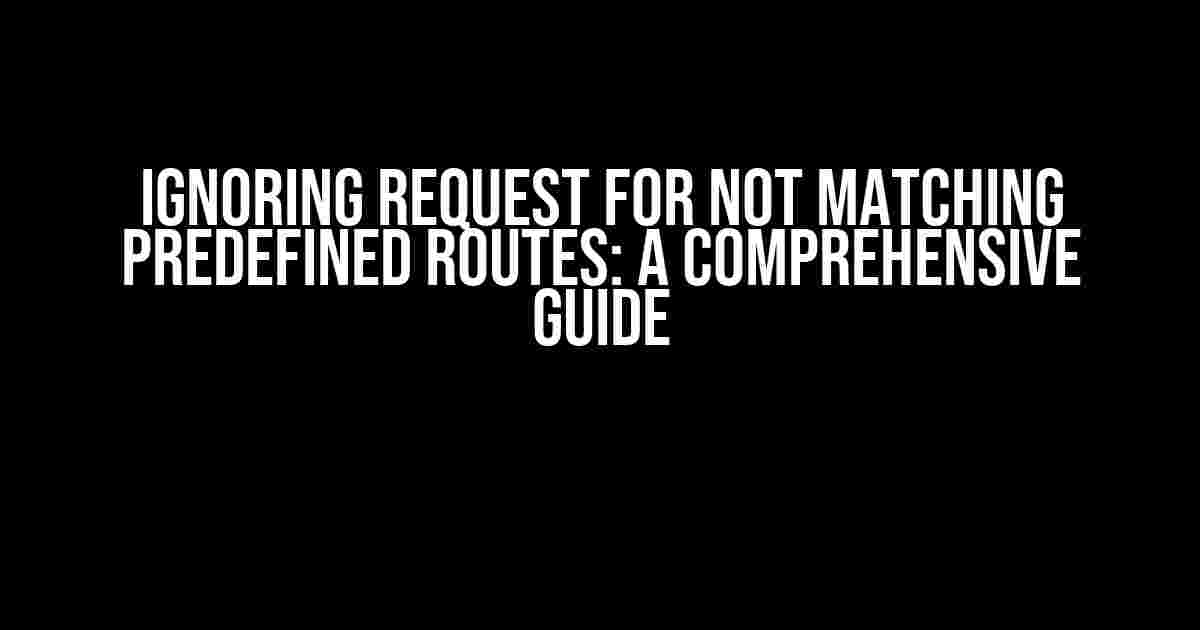Have you ever encountered an error message stating “Ignoring request for not matching predefined routes” in your application? If so, you’re not alone! This error can be frustrating, especially when you’re unsure of what’s causing it or how to resolve it. Fear not, dear developer, for we’re about to embark on a journey to demystify this error and provide you with clear, actionable steps to overcome it.
What Does the Error Mean?
The error “Ignoring request for not matching predefined routes” typically occurs when your application receives a request that doesn’t match any of the predefined routes in your routing configuration. This can happen when:
- A user types an incorrect URL in their browser.
- A malicious actor is attempting to exploit your application by sending requests with invalid routes.
- There’s a misconfiguration in your routing setup.
In any case, your application is essentially saying, “Hey, I don’t recognize this route, so I’m going to ignore it!”
Understanding Routing Configurations
Before we dive into the solutions, let’s take a step back and understand how routing configurations work in general. Routing configurations are a critical part of web applications, as they define how incoming requests are handled and directed to specific controllers, actions, or views.
In most web frameworks, routing configurations are typically defined in a routing file or a separate configuration file. This file contains a set of rules that dictate how to handle incoming requests based on factors such as:
- HTTP method (GET, POST, PUT, DELETE, etc.).
- Request URL.
- Query parameters.
- Route parameters.
When a request is received, the routing configuration is consulted to determine which controller, action, or view to direct the request to. If no matching route is found, the error “Ignoring request for not matching predefined routes” is thrown.
Solutions to the Error
Now that we’ve covered the basics, let’s get to the good stuff – solving the error!
Solution 1: Verify Routing Configurations
The first step in resolving this error is to review your routing configurations to ensure they’re correctly defined and up-to-date. Double-check that:
- All routes are properly defined and formatted.
- Route names and URLs match exactly.
- HTTP methods are correctly specified.
- Query and route parameters are properly handled.
// Example of a simple routing configuration in Express.js
const express = require('express');
const app = express();
app.get('/', (req, res) => {
res.send('Home page');
});
app.get('/users', (req, res) => {
res.send('Users page');
});
app.post('/users', (req, res) => {
res.send('Create new user');
});
app.listen(3000, () => {
console.log('Server started on port 3000');
});
Solution 2: Implement a Catch-All Route
In some cases, you might want to provide a default response for requests that don’t match any predefined routes. This is where a catch-all route comes in handy.
// Example of a catch-all route in Express.js
app.all('*', (req, res) => {
res.status(404).send('Not Found');
});
In this example, the `app.all` method catches any request that doesn’t match a predefined route and returns a 404 status code with a “Not Found” message. You can customize this response to suit your application’s needs.
Solution 3: Use a Route Debugger
Route debuggers are tools that help you visualize and debug your routing configurations. They can be incredibly useful in identifying issues with your routes and resolving the “Ignoring request for not matching predefined routes” error.
For example, in Laravel, you can use the `route:list` command to display a list of all defined routes:
php artisan route:list
This will output a table with information about each route, including the method, URL, name, and action.
| Method | URI | Name | Action |
|---|---|---|---|
| GET | / | home | App\Http\Controllers\HomeController@index |
| GET | /users | users.index | App\Http\Controllers\UserController@index |
Solution 4: Review Server Logs
Sometimes, the error might be related to a misconfiguration on the server-side. Reviewing server logs can help you identify issues with your routing setup or other server-related problems.
// Example of a server log entry
[2022-01-01 12:00:00] local.ERROR: RuntimeException: Route not defined in /path/to/routes.php
In this example, the server log indicates that a `RuntimeException` occurred due to a missing route definition in the `routes.php` file.
Best Practices to Avoid the Error
To minimize the occurrence of the “Ignoring request for not matching predefined routes” error, follow these best practices:
- Keep your routing configurations organized and up-to-date.
- Use route debugging tools to visualize and test your routes.
- Implement a catch-all route to handle unexpected requests.
- Regularly review server logs for any routing-related issues.
- Use version control to track changes to your routing configurations.
By following these best practices and solutions, you’ll be well-equipped to handle the “Ignoring request for not matching predefined routes” error and provide a seamless user experience for your application’s users.
Remember, debugging and resolving errors is an essential part of the development process. Stay vigilant, and don’t let errors like this one get in the way of delivering a fantastic application!
Frequently Asked Question
Got questions about ignoring requests for not matching predefined routes? We’ve got answers! Check out our FAQs below:
What happens when a request doesn’t match any predefined route?
When a request doesn’t match any predefined route, it will be ignored. This is a security feature to prevent unauthorized access to your system. If you’re expecting a specific request, make sure to define a route that matches it!
How do I define a predefined route?
Defining a predefined route is easy! You can do it by specifying the exact URL, method, and any other required parameters in your route configuration file. For example, if you want to allow GET requests to /api/data, you would add a route with the method ‘GET’ and the path ‘/api/data’. Simple, right?
Can I customize the error message for ignored requests?
Yes, you can customize the error message for ignored requests! You can set a custom error message or page to be displayed when a request is ignored. This can be useful for providing a better user experience and reducing confusion. Just configure your error handling settings to display your custom message!
Will ignored requests affect my system’s performance?
Ignored requests should not significantly affect your system’s performance. Since the request is ignored, it won’t consume any system resources or execute any code. However, if you’re receiving a high volume of ignored requests, it may be worth investigating the cause to prevent any potential issues!
How can I troubleshoot ignored requests?
Troubleshooting ignored requests can be a breeze! Start by checking your route configuration to ensure that the request matches a defined route. If it doesn’t, you can try enabling debug logging to get more insights into the request and response. You can also use tools like request analysers to help identify the issue!



